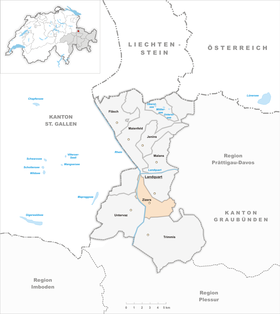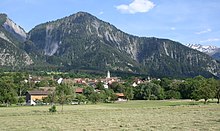Zizers
| Zizers | |
|---|---|
| State : |
|
| Canton : |
|
| Region : | Landquart |
| BFS no. : | 3947 |
| Postal code : | 7205 |
| Coordinates : | 761 938 / 200561 |
| Height : | 561 m above sea level M. |
| Height range : | 513–1773 m above sea level M. |
| Area : | 11.01 km² |
| Residents: | 3434 (December 31, 2018) |
| Population density : | 312 inhabitants per km² |
| Website: | www.zizers.ch |
|
Zizers |
|
| Location of the municipality | |
Zizers ( Romansh or ) is a municipality in the Landquart region in the canton of Graubünden in Switzerland .
geography

The street village of Zizers is located on a flat hillside surrounded by mountains and wine-growing region 10 km north of the canton capital Chur in the Graubünden Rhine Valley (also known as the Chur Rhine Valley). On the right bank of the Rhine , the territory extends from the river over the slope furrowed by the Schlundrüfi and Chessirüfi torrents to the ridge that forms the watershed to the Valzeina valley . There, in the far south-east, at the Cyprianspitz , the greatest height is reached at 1774 m . The area to the left of the Rhine, which previously also belonged to Zizers, has formed the independent municipality of Mastrils since 1854 and was merged with Igis to form the municipality of Landquart in 2012.
In 1997, 41.5% of the municipal area was used for agriculture, the forest took up 38.5%, the settlements 12.1%. 7.8% were considered unproductive.
Zizers borders on the municipalities of Landquart , Valzeina , Trimmis , Untervaz and Maienfeld .
coat of arms
Blazon : In silver (white) an upright striding, red-tongued and so decorated, black ibex, carrying a fallen black key
The community seal used in 1527 already showed the heraldic animal of the church association . The key, the attribute of the patron saint Peter , is used for differentiation.
history
The village, located on the main traffic route of the Deutsche Strasse , the connection from the Lake Constance area to Chur and on to the Graubünden Alpine passes, is documented in 824 as Zizuris . Finds from the Bronze and Roman Ages suggest a much older settlement origin. The origin of the place name, which some researchers want to trace back to the Roman poet Zizerus or a goddess Ziza, is unclear. In 955 Otto the Great donated the royal court at Zizers including the associated church to the Diocese of Chur , where he had appointed his favorite Hartpert as bishop. This royal court was discovered by chance during excavation work in 2010 and has been reconstructed since then.
The economy of the small town-looking village, gifted with market rights, rested on several pillars: In addition to agriculture (wine, fruit and arable farming), various branches of handicraft have been documented since the Middle Ages. Trade and hospitality flourished in the vicinity of the Sust . In 1519 the episcopal dominions Friedau and Alt-Aspermont constituted the High Court Four Villages of the Church of Gods Association with Zizers as the main town (3/7 of the voting rights). In 1649 the last episcopal rights were replaced and thus full sovereignty within the three leagues was achieved. Both denominations have been represented in the community since the 17th century.
population
| Population development | |||||||
|---|---|---|---|---|---|---|---|
| year | 1850 | 1900 | 1950 | 1980 | 2000 | 2005 | 2010 |
| population | 925 | 1107 | 1281 | 2425 | 2983 | 3064 | 3201 |
economy
Even if agriculture has lost its paramount importance, orchards and vineyards shape the townscape. Zizers, known for its Pinot Noir , is located in a classic Föhntal in north-south orientation at an altitude of approx. 600 m and is therefore one of the warmest German-speaking wine-growing regions. Otherwise, medium-sized businesses dominate. Together with the neighboring municipality of Landquart, the Tardisland industrial zone , which is conveniently located on the railway line and the motorway, is being developed and marketed. 74 people were employed in agriculture and forestry, 144 in the commercial sector and 447 in the service sector (as of 2000–01).
traffic
The community has a train station on the half-hourly Chur – Landquart line of the Rhaetian Railway . There is also a post bus line from Landquart train station to Zizers. Due to its location on the A13 motorway , the canton capital can be reached in a ten-minute drive, Zurich, Sankt Gallen and Davos in around an hour.
tourism
In the community of Zizers there is an indoor swimming pool, an indoor facility with tennis, sauna, squash and billiards as well as a beach volleyball facility with two fields. Together with the integration into a large network of hiking and cycling trails in a varied landscape - from the banks of the Rhine with its floodplain forests to the meadows and fruit trees on the slope - Zizers is part of the Graubünden tourist region.
education
The higher technical school for social pedagogy of the God helps foundation is domiciled in Zizers .
Attractions
After several large village fires (most recently in 1767 and 1897), modern buildings dominate the image of the main street. However, there are a number of excellent individual objects:
- The Catholic parish church of St. Peter and Paul was built in the 15th century in place of a Romanesque predecessor and refurbished in the Baroque style in 1767 after fire damage .
- In the upper part of the village is the Reformed Church , mentioned as St. Andrew in 1340, handed over to the Reformed community in 1644 and expanded in 1711.
- The landmark of Zizers is the dome tower of the Lower Castle. As the headquarters of the Salis-Zizers line, built in several phases from 1620 to 1687, the castle housed an old people's home, the St. Johannes Stift, from 1899 to 2015. The interiors are not open to the public. Zita , the last Empress of Austria and Queen of Hungary, spent the last years of her seventy years of exile at St. Johannes Stift from 1962 until her death on March 14, 1989.
- Upper lock
- Not far from the train station rises the ruins of Friedau Castle, which was built in the 13th century as the episcopal center of power . Acquired by the Four Villages in 1649, the four-storey tower was used as a prison at times. It was damaged in the village fire in 1897 and has been in ruins ever since.
Personalities
- Bartholomäus Anhorn the Elder (1566–1642), Evangelical Reformed pastor and historian in Graubünden and Appenzell, in Zizers 1612–1614
- Rudolf von Salis-Zizers (1779–1840), field marshal lieutenant in Austrian service
- Leonz Held (1844–1925), topographer, cartographer, geodist and officer born in Zizers
- Zita von Bourbon-Parma (1892–1989), the wife of Emperor Charles I from 1916 to 1918, last Empress of Austria and Queen of Hungary, lived in Zizers from 1962 until her death on March 14, 1989
literature
- Erwin Poeschel : The Art Monuments of the Canton of Graubünden, Volume VII: The City of Chur and the Circle of Five Villages. (= Art Monuments of Switzerland. Volume 20). Edited by the Society for Swiss Art History GSK. Bern 1948, DNB 760079668 .
Web links
- Official website of the municipality of Zizers
- Adolf Collenberg: Zizers. In: Historical Lexicon of Switzerland .
- Zizers on the ETHorama platform
Individual evidence
- ↑ Permanent and non-permanent resident population by year, canton, district, municipality, population type and gender (permanent resident population). In: bfs. admin.ch . Federal Statistical Office (FSO), August 31, 2019, accessed on December 22, 2019 .
- ↑ Catholic parish church of St. Peter and Paul at www.graubuendenkultur.ch
- ↑ Lower Castle at www.graubuendenkultur.ch
- ↑ Upper Castle at www.graubuendenkultur.ch. For the building history and restoration, see p. Bündner Jahrbuch 2017, 125-144.





